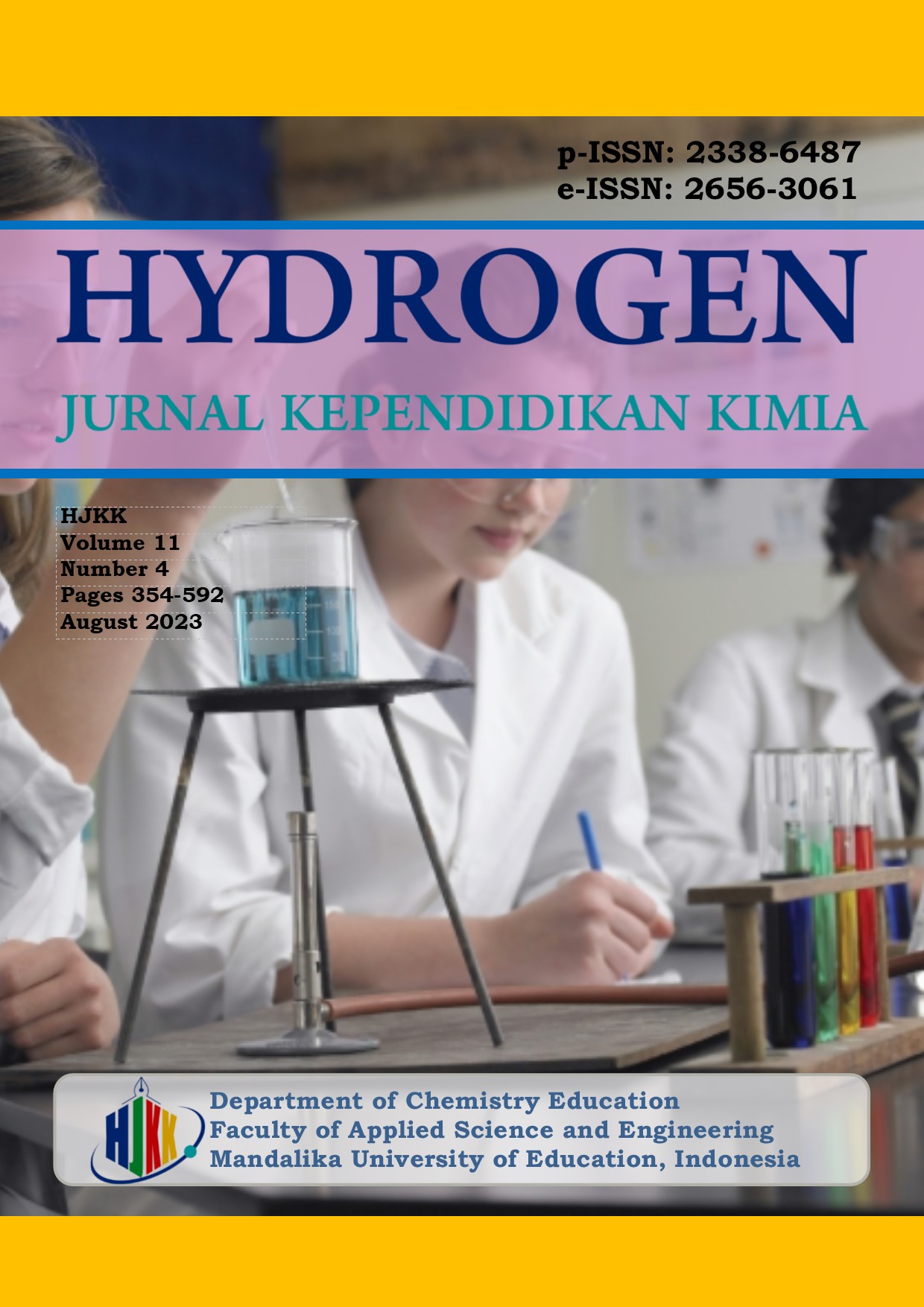Development of Website-Based Learning Media on Reaction Rate Material to Improve Student Learning Outcomes
DOI:
https://doi.org/10.33394/hjkk.v11i4.8523Keywords:
feasibility of learning media, reaction rate, web-based lerning mediaAbstract
This development research aims to describe the feasibility of website-based learning media for reaction-rate material. The feasibility of learning media is reviewed in terms of validity, practicality, and effectiveness. Media validity is measured by content validity and construct validity. The practicality of the media is measured by student responses and activities. Effectiveness is measured by the percentage of classical completeness and the improvement of students' learning outcomes. The research method used in this research is Borg and Gall's Research and Development (R&D) method, which has been modified by Sukmadinata. Media trials were conducted at SMA Negeri 20 Surabaya on 33 students of class XI MIPA 2 who had previously received reaction rate material. This website-based learning medium is declared feasible. The results of content and construct validity show valid results in each aspect with a mode between 4 and 5. Practicality results show that web-based learning media is practical with 98,10% of relevant student activities at the first meeting and 99,05% at the second meeting, while the percentage acquisition of each aspect in the student response gets a percentage of  90%. The results of the effectiveness of learning media obtained classical completeness results of 87.9% and an N-Gain score of 0.78. This is supported by the results of the Paired sample t-test of 0.000, which means there is a significant average difference in learning outcomes.
References
Cakmakci, D., Donnelly, J., & Leach, J. (2003). A Cross-Sectional Study of the Understanding of the Relationships Between Concentration and Reaction Rate Among Turkish Secondary and Undergraduate Students. European Science Educational Research Association (ESERA) Conference.
Harmoko, T. J., Karmanto, & Suprihatiningrum, J. (2017). Pengembangan Media Pembelajaran Kimia Berbasis Web untuk SMA/MA. Jurnal Pendidikan Sains (JPS), 5(2), 113–119.
Hasibuan, A. T., & Prastowo, A. (2019). Konsep Pendidikan Abad 21: Kepemimpinan dan Pengembangan Sumber Daya Manusia SD/MI. Magistra, 10(1), 26–50.
Kustandi, C., & Sutjipto, B. (2011). Media Pembelajaran Manual dan Digital. Bogor: Ghalia Indonesia.
Nurchaili. (2010). Pengaruh Media Pembelajaran Berbasis Teknologi Informasi dalam Proses Pembelajaran Kimia Terhadap Peningkatan Hasil Belajar Siswa. Jurnal Pendidikan Dan Kebudayaan, 16(6), 648–658.
Rahman, S., Munawar, W., & Berman, E. T. (2014). Pemanfaatan Media Pembelajaran Berbasis Website Pada Proses Pembelajaran Produktif di SMK. Journal of Mechanical Engineering Education, 1(1), 137–145.
Riduwan. (2015). Dasar-Dasar Statistika. Bandung: Alfabeta.
Suardi. (2019). Pengaruh Kepuasan Kerja Terhadap Kinerja Pegawai Pada PT Bank Mandiri, Tbk Kantor Cabang Pontianak. Journal Business Economics and Entrepreneurship, 1(2), 9–18.
Sukmadinata, N. S. (2016). Metode Penelitian Pendidikan. Bandung: PT Rosdakarya.
Supriyah. (2019). Media Pembelajaran dalam Proses Belajar Mengajar. Prosiding Seminar Nasional Pendidikan FKIP, 2(1), 470–477.
Trianto. (2009). Mendesain Model Pembelajaran Inovatif-Progresif. Jakarta: Prenada Media Group.
Widiyono, A., & Millati, I. (2021). Peran Teknologi Pendidikan dalam Perspektif Merdeka Belajar di Era 4.0. Journal of Education and Teaching, 2(1), 1–9.
Downloads
Published
How to Cite
Issue
Section
Citation Check
License
License and Publishing Agreement
In submitting the manuscript to the journal, the authors certify that:
- They are authorized by their co-authors to enter into these arrangements.
- The work described has not been formally published before, except in the form of an abstract or as part of a published lecture, review, thesis, or overlay journal.
- That it is not under consideration for publication elsewhere,
- That its publication has been approved by all the author(s) and by the responsible authorities – tacitly or explicitly – of the institutes where the work has been carried out.
- They secure the right to reproduce any material that has already been published or copyrighted elsewhere.
- They agree to the following license and publishing agreement.
Copyright
Authors who publish with Hydrogen: Jurnal Kependidikan Kimia agree to the following terms:
- Authors retain copyright and grant the journal right of first publication with the work simultaneously licensed under a Creative Commons Attribution License (CC BY-SA 4.0) that allows others to share the work with an acknowledgment of the work's authorship and initial publication in this journal.Â
- Authors are able to enter into separate, additional contractual arrangements for the non-exclusive distribution of the journal's published version of the work (e.g., post it to an institutional repository or publish it in a book), with an acknowledgment of its initial publication in this journal.
- Authors are permitted and encouraged to post their work online (e.g., in institutional repositories or on their website) prior to and during the submission process, as it can lead to productive exchanges, as well as earlier and greater citation of published work.
Licensing for Data Publication
Hydrogen: Jurnal Kependidikan Kimia uses a variety of waivers and licenses, that are specifically designed for and appropriate for the treatment of data: Open Data Commons Attribution License, http://www.opendatacommons.org/licenses/by/1.0/ (default) Other data publishing licenses may be allowed as exceptions (subject to approval by the editor on a case-by-case basis) and should be justified with a written statement from the author, which will be published with the article.







